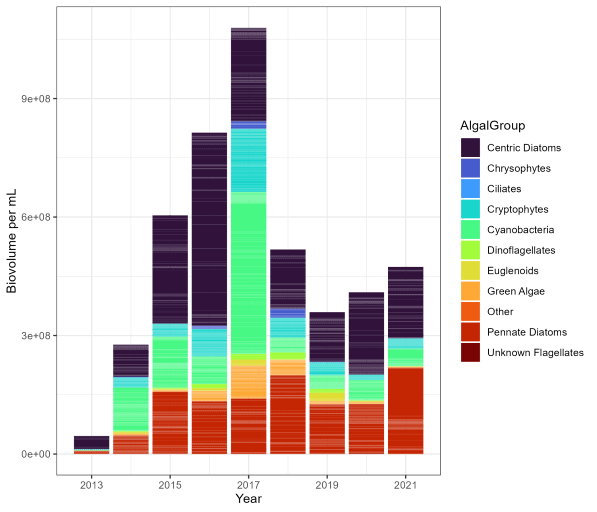The base of the estuarine food web is phytoplankton – microscopic, floating, single-celled organisms drifting on the currents (“phyto” meaning “plant” and “plankton” meaning “drifter”). Most people know that trees produce oxygen, but phytoplankton put them to shame. Phytoplankton in rivers, lakes, and oceans worldwide produce an estimated 80% of the world’s supply of oxygen. Phytoplankton are also the base of the aquatic food web – providing food for zooplankton, other invertebrates, and fish. They are also the source of the omega-3 fatty acids(opens in new tab) that make seafood so good for you!
The Environmental Monitoring Program, a collaborative team of scientists and technicians from DWR, USBR, and CDFW, have been collecting phytoplankton samples to monitor the status and trends of phytoplankton in the San Francisco Estuary for the past forty years, and just recently made their data from 2008-2021 available online!
How are the data collected?
- The monitoring program crew go out on DWR’s premier research vessel, the Sentinel, once per month and visit 24 fixed stations and 2-4 ‘floating’ stations across San Pablo Bay, Suisun Bay, and the Delta.
- At each station, scientists collect a 60 mL water sample from 1 meter depth and stain it with Lugol’s iodine solution to make the phytoplankton easier to see.
- The samples are shipped to a lab where highly-trained taxonomists identify and count the phytoplankton under high-powered microscopes.
What do the data look like?
For each sample, we see the count (number of cells) for each type of plankton as well as the size (biovolume) of these cells.
- Each phytoplankter is identified to genus or species, but we often lump them into larger taxonomic groups to make it easier to […]
Full article: Science Stories: Adventures in Bay-Delta Data

